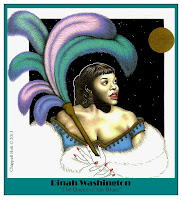Women of the Blues, Pt. 1
I started out as a rock musician basing my style on
American Blues, specifically the Country Blues of the American South. I conjured
the blues in my life, invoked their gods, called upon their demons by singing
the words, invoking that blues condition of mind. I have been down to the
crossroads. I got the key to the highway. I would’ve gone down that big road all
by myself.
The blues entered me, passed through me and become
something else. When I wrote a blues song it became a unique statement. I did
not merely duplicate what was conjured and rehearsed in the early stages of
learning, though I closely followed in the steps of the past masters.
Eventually, I found new direction in myself, different from the one charted by
the traditional language of the blues. I developed my own style of performing
and songwriting.
I was allowed to audit my girlfriend’s classes at Sonoma
State University (Rohnert Park, CA) from 1970 – 1973 so I received a great
education while she was going there. Philip Elwood, jazz columnist for the
Oakland Tribune, was teaching a History of Jazz course that I audited. Her
assignments introduced me to wonderful new books, all of them previously unknown
to me, and I read them all right along with her—Ishi in Two Worlds, Black Elk
Speaks, Blues People, Urban Blues, and others. These communities, formerly
excluded from our experience, worlds of marginalized, non-white cultures, were
liberated for entry into our imaginations, for us to learn about and enjoy. It
was a gas, a moment of cultural transformation to recall forever. We still see
the permanent effects of these changes today.
Many rock and pop women singers of those days explored
their interest in the blues and jazz traditions of the black community. They
followed the lead of elders and scholars like Maria Muldaur, Bonnie Raitt, Janis
Joplin and several others. Pamela Polland, who already had experience performing
with blues scholar Ry Cooder when they were both kids starting out in Los
Angeles, shared her expertise with me. With my help as backup pianist (pictured
above), she created a blues act, “Melba Rounds,” that featured the songs of Ethel Waters, Lil
Greene, Bessie Smith, Billy Holiday and of course Barbecue Bess, Bessie Jackson
(“talkin’ ‘bout my barbecue.”) Pamela also got help from Sonoma State Professor
Phil Elwood who taught the jazz history class I’d sat in on a few years before.
Elwood let her explore and tape record from his extensive collection to get
material.
One of the first songs Pamela found among Professor Phil’s records was “Why Don’t You
Do Right?” by Lil Green, with Big Bill Broonzy on guitar. Pamela fell in love
with the song and it became a popular one in her repertoire. Although we learned
it from Lil Green, Peggy Lee had the biggest hit with her version. Peggy had
also learned it from Lil Green’s recording. In a 1984 interview she said "I was
and am a fan of Lil Green, a great old blues singer, and Lil recorded it. I used
to play that record over and over in my dressing room, which was next door to
Benny's (Goodman). Finally he said … 'Would you like me to have an arrangement
made of it?' I said, 'I'd love that,' and he did." “Why Don’t You Do Right?”
became a hit for her and the Benny Goodman orchestra in 1942 and sold over a
million copies.
Bessie Smith provided many crowd pleasers for Pamela’s
show. One was Bessie’s typically rough and tough “Send Me to the ‘Lectric
Chair,” where she sings, “I wanna take a journey to the devil down below. I done
killed my man. I wanna reap just what I sow.” Dinah Washington included it on
her tribute album to Bessie.
Chappell has written a fine tribute to these singers
with her song “Bad Girls Blues,” soon to be released on our CD Stone and Fire.
In one verse, she sings about Sippie Wallace, singer-songwriter of the tune
“Women Be Wise,” that was popularized by Bonnie
Raitt. “Sippie warned us not to tell our secrets, Lest she come and
steal away your man.” (Photo is from Bonnie Raitt and Sippie Wallace’s 1970's
tour backed up by fellow FAR-West musician, Freebo).
Our use of the American music traditions of
jazz and the blues, as well as folk and country, have earned the descriptor,
“the jazzy side of Americana,” for Chappell & Dave Holt’s music. We enjoy
the privilege of sharing the jazz and blues of our national folk music with our
audiences.
More next week
…
All illustrations owned and copywritten by Chappell Holt.




No comments:
Post a Comment